Jackie Damrau, Editor — Each issue of Technical Communication includes a Book Reviews section covering the most relevant new books in the field. In this issue eleven new books are reviewed.
Health and Risk Communication: An Applied Linguistic Perspective
by Rodney H. Jones
Brand Journalism
by Andy Bull
Design for Kids: Digital Products for Playing and Learning
by Debra Levin Gelman
Words Onscreen: The Fate of Reading in a Digital World
by Naomi S. Baron
How We Learn: The Surprising Truth About When, Where, and Why It Happens
by Benedict Carey
You Can Say That Again: 750 Redundant Phrases to Think Twice About
by Marcia Riefer Johnston
Blogging for Writers: How Authors & Writers Build Successful Blogs
by Robin Houghton
Intertwingled: Information Changes Everything
by Peter Morville
Type. A Visual History of Typefaces & Graphic Styles
by Cees W. de Jong, Alston W. Purvis, and Jan Tholenaar, eds.
Theories of the Information Society
by Frank Webster
Global Content Strategy: A Primer
by Val Swisher
Health and Risk Communication: An Applied Linguistic Perspective
Rodney H. Jones. 2013. New York, NY: Routledge. [ISBN 978-0-415-67260-3. 212 pages, including index. US$39.95 (softcover).]
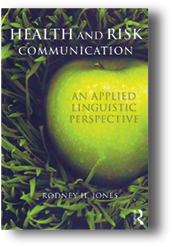 Health and Risk Communication: An Applied Linguistic Perspective is a thoughtful analysis of health and risk as seen through the lens of applied linguistics. Rodney Jones addresses several questions in this book that include how health discourse shapes a patient’s understanding of their condition as well as how it influences their decisions regarding their health. Jones also addresses the role of technology, such as genetic screening, and how health communication can help create communities centered on specific health issues.
Health and Risk Communication: An Applied Linguistic Perspective is a thoughtful analysis of health and risk as seen through the lens of applied linguistics. Rodney Jones addresses several questions in this book that include how health discourse shapes a patient’s understanding of their condition as well as how it influences their decisions regarding their health. Jones also addresses the role of technology, such as genetic screening, and how health communication can help create communities centered on specific health issues.
The rhetorical analysis in the book builds on the work of many well-known works in health rhetoric, like Foucault’s The Birth of the Clinic. Jones adds to the existing conversation in the rhetoric of health communication by examining current issues in healthcare, such as how medical research, or “the voice of medicine” and a patient’s personal experiences, or “the voice of the lifeworld” clash. According to Jones, an example of this conflict occurs when parents decide whether to vaccinate their children. On one hand, disease outbreaks among unvaccinated children have made it evident that not vaccinating children can lead to contracting serious illnesses. However, on the other hand, parents who identify as “anti-vaxxers” feel that the risk of contracting these illnesses is minor when compared to the potential negative effects of receiving the vaccinations, such as the perceived risk of the child developing autism from the vaccine.
The medical issues analyzed in Health and Risk Communication are timely and understandable. Jones uses medical situations that most readers will immediately recognize either from personal experience or from the news, such as the 2012 Texas mandate that any woman who seeks an abortion must first undergo an ultrasound. These concrete examples are a major strength of the text because they allow a reader with less experience in applied linguistics to follow his analysis of the medical text or communication.
Despite the clarity and timeliness of the examples, the analysis in Health and Risk Communication makes for a slow and careful reading experience. This is not a text to which the reader can devote anything less than their full attention. Although Jones covers the basics of applied linguistics in chapter 2, Health and Risk Communication is a much easier read for those who have a background in this method of analysis. However, for those who take time to follow Jones’s detailed analysis, the rewards are worth the effort.
The main audience for Health and Risk Communication: An Applied Linguistic Perspective is academics interested in the rhetoric of health communication. Health practitioners and technical writers working in the health fields may also benefit from this book’s examination of communication and power. This text may also benefit graduate students in technical writing as well as medical students who are interested in issues of communication in healthcare settings.
Nicole St. Germaine-Dilts
Nicole St. Germaine-Dilts is an associate professor in the Technical and Business Writing Program at Angelo State University. Her research interests include technical communication for a Mexican-American audience and technical communication in the health fields.
Brand Journalism
Andy Bull. 2013. New York, NY: Routledge. [ISBN 978-0-415-63810-4. 288 pages, including index. US$43.95 (softcover).]
 In Brand Journalism, Andy Bull bundles communication, marketing, and journalism principles into one neat how-to package. On the Routledge Web site, the book is described as a response to “the newly-emerging trend of organisations hiring journalists to create content on their behalf” (http://www.routledge.com/books/details/9780415638104/). From my perspective the concept of brand journalism, as Andy Bull presents it, is a fascinating outcome of the decline of traditional journalism and the increased pressure in the market for brands to differentiate themselves amidst a tidal wave of ever-evolving media options.
In Brand Journalism, Andy Bull bundles communication, marketing, and journalism principles into one neat how-to package. On the Routledge Web site, the book is described as a response to “the newly-emerging trend of organisations hiring journalists to create content on their behalf” (http://www.routledge.com/books/details/9780415638104/). From my perspective the concept of brand journalism, as Andy Bull presents it, is a fascinating outcome of the decline of traditional journalism and the increased pressure in the market for brands to differentiate themselves amidst a tidal wave of ever-evolving media options.
As I began reading, I found that there was nothing groundbreaking or new about the approach. In Section One, Bull describes how to build a brand journalism strategy. A sound yet generic approach, giving readers nothing that they couldn’t find in any good marketing or communications textbook.
Each chapter ends with recommended exercises that cause an awkward juxtaposition. These exercises are presumably for students or those new to the field, yet the content is more for experienced professionals. As an example, Bull provides advice on how to establish a brand journalism department staffed with multiple employees, equipped with expensive technology, and occupying office space. This is not student or entry level material. Most communication professionals would need to be well along in their careers before they attained a level high enough to open a new department.
Brand Journalism becomes interesting when Bull begins presenting case studies in Section Two. He interrogates case studies of well-known brands from Ford to Red Bull to McDonald’s to uncover how they succeeded, and sometimes failed, in their attempts to bolster their brands. Where Bull falls down is his inconsistent depth of analysis. In Section Two, we are treated to seven chapters of thorough examinations of brand journalism platforms. By the time we get to Section Three, which provides a review of storytelling paths, the depth of coverage becomes increasingly shallow. On the other hand, the number of case studies increases, so what is lacking in depth Bull makes up for in breadth . . . yet I personally prefer both.
Section Four covers metrics—the philosopher’s stone of communications. This is typically the topic writers can’t stop gushing about. I was surprised, then, to find only three chapters in this sparse section. I am tempted to excuse the author on grounds that solid measurement for communications is, as I noted, elusive. It’s elusive because it’s hard. Because it’s hard, most organizations find a way to avoid it. But then again, I have been around enough to know there are companies that absolutely nail measurement, showing strict line of sight from strategy to execution to business impact. I was disappointed that Brand Journalism didn’t cover this topic more exhaustively.
What I liked about Brand Journalism was the case studies. I enjoyed stealing a view into how other companies market their brands through innovative means. What I wanted more of was consistent depth.
Gary Hernandez
Gary Hernandez is a communications director for an international oil company. He received his English literature MA from George Mason University and received his technical writing MS from Utah State University. Gary belongs to STC and IABC.
Design for Kids: Digital Products for Playing and Learning
Debra Levin Gelman. 2014. Brooklyn, NY: Rosenfeld Media. [ISBN 978-19-338-2030-9. 232 pages, including index. US$39.00 (softcover).]
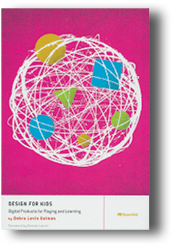 If you have kids who are digitally literate, you know the joys and sorrows they experience when trying to play games on the Web or a smartphone. Why those swings in emotion? Kids with short attention spans quit games after a few minutes of frustration. Often the source lies in the game design. Debra Gelman addresses why games go wrong for kids in her Design for Kids: Digital Products for Playing and Learning.
If you have kids who are digitally literate, you know the joys and sorrows they experience when trying to play games on the Web or a smartphone. Why those swings in emotion? Kids with short attention spans quit games after a few minutes of frustration. Often the source lies in the game design. Debra Gelman addresses why games go wrong for kids in her Design for Kids: Digital Products for Playing and Learning.
The problem she addresses, as Brenda Laurel points out in the Foreword, is that kids are often thought of as not demanding careful design of their games. Most early Web designs assumed that kids were little adults and the designs that worked for adults should work for kids if they were dumbed down. Another important problem leading to frustration is an educational assumption: play and learning are two separate activities. In elementary school, recess was the time for play and classroom the time for learning. As the child progresses, the schools allocate less time to play until a point where there is no play at all during school hours.
Gelman argues that play can be a part of learning, and her book presents a guide on how to design to incorporate both.
The key to Design for Kids is a comment Gelman makes that summarizes her advice: “. . . you should design [for kids] as you would for adults, by understanding your target users’ needs, behaviors, and attitudes” (p. 134; emphasis added). But, this has long been rule number 1 for technical communicators. So, why have these designers been ignoring it? Her answer is poor user analysis.
Gelman divides her book into three parts: In Part one, she surveys past design approaches, analyzing those designs showing strengths and weaknesses. She follows up on this conclusion by discussing how learning should be part of play just as in a classroom. In the final chapter of this Part, she discusses kids’ development based on Piagét’s Theory of Cognitive Development.
Part two takes us into the kids’ world. She divides kids into two-year groups starting with 2–4 year olds, and ending with kids 10–12. For each grouping, Gelman presents some theory, but more importantly, specific design advice. Screen shots, lists of various kinds, interviews, case studies, and chapter checklists are among the features that make her work accessible.
Finally, Part three offers suggestions for doing research on kids. She provides an example of embedding a video in the site or app, and how the design handles that for the age groups. The last chapter is a checklist based on what has come before and questions designers need to ask, some design particulars, and suggestions on getting the final product published.
All in all, Design for Kids provides the information designers need when they design Web sites and apps for kids.
Tom Warren
Tom Warren is an STC Fellow, Jay R. Gould Award for Excellence recipient, and professor emeritus of English (technical writing) at Oklahoma State University, where he established the BA, MA, and PhD technical writing programs. Past president of INTECOM, he serves as guest professor at the University of Paderborn, Germany.
Words Onscreen: The Fate of Reading in a Digital World
Naomi S. Baron. 2015. New York, NY: Oxford University Press. [ISBN 978-0-19-931576-5. 304 pages, including index. US$24.95.]
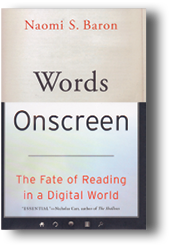 Naomi Baron has written a prophetic call to look at what digital reading is doing to us, and whether it should be challenged. She does her own research, formal and informal, and examines the scholarship. Her conclusion: Yes, we should challenge it. Why?
Naomi Baron has written a prophetic call to look at what digital reading is doing to us, and whether it should be challenged. She does her own research, formal and informal, and examines the scholarship. Her conclusion: Yes, we should challenge it. Why?
Reading onscreen is changing the way we read and what it means to read. Digital reading encourages the kind of fast reading that most of us create as technical communicators, which focuses on searching for solutions to problems. It does not encourage slow reading, the type that allows us to contemplate, absorb, and reread. Not everything is meant for slow reading, but digital reading does not encourage the type of reading required for literature, philosophy, and sacred texts.
Two of Baron’s chapters alone are worth the price of the book: Chapter 5 “The Web Ate My Print Option” and Chapter 8 “Your Brain and Hyper Reading.” The former chapter explores the phenomenon of the loss of the print option for Internet reading. I, for one, am so tired of printing badly formatted documents. It’s another case of the developers not knowing what the users want. Technical communicators as user advocates need to stand up for readers who want to annotate, reread, and save what they read for future use.
Chapter 8 “Your Brain on Hyper Reading” gathers all writers who are challenging what reading online is doing to us, plus the scientific research that shows how the brain is changing or not changing with regard to reading technology.
Baron challenges the notion that online reading is environmentally better than print, citing the heavy use of servers and the huge amounts of energy they require.
At the heart of the issue is a challenge to businesses and organizations that stand to benefit from digital reading: “Businesses (such as Amazon and Kobo) and educational establishments (whether CourseSmart or state boards of education) are working to change the culture of reading by replacing print with screens” (p. 205). Or as she puts it more succinctly—where you stand on this issue depends on where you sit.
Baron invites us to stand and challenge those whose economic interests may be at odds with those of us for whom the printed book is a sacred object, which perhaps cannot be improved upon.
Charles R. Crawley
Charles R. Crawley is a lead technical writer at Rockwell Collins in Cedar Rapids, Iowa. He also teaches as an adjunct at Mount Mercy University in Cedar Rapids. He just finished his third term (not consecutive) as the president of the Eastern Iowa Chapter of the STC.
How We Learn: The Surprising Truth About When, Where, and Why It Happens
Benedict Carey. 2014. 1st ed. New York, NY: Random House. [ISBN: 978-0-8129-9388-2. 254 pages, including index. US$27.00.]
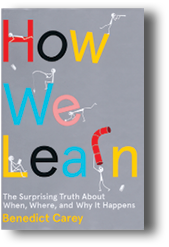 There is an invisible line that some practitioners draw between the development of technical content for product documentation and learning modules. For example, when organizations establish different departments for technical writing and education. This line seems arbitrarily drawn because, as technical communicators, we are educating. I heartily recommend Benedict Carey’s How We Learn: The Surprising Truth About When, Where, and Why It Happens regardless of how you define your role.
There is an invisible line that some practitioners draw between the development of technical content for product documentation and learning modules. For example, when organizations establish different departments for technical writing and education. This line seems arbitrarily drawn because, as technical communicators, we are educating. I heartily recommend Benedict Carey’s How We Learn: The Surprising Truth About When, Where, and Why It Happens regardless of how you define your role.
Carey, an esteemed New York Times science reporter, wrote this book for a general audience. He divides the material into four easy-to-read parts. The first part, Basic Theory, is my least favorite part. Yet, this part was valuable enough that I re-read it to make sure I had the theory of memory and the biology of the brain stored for easy retrieval.
The theory section is not all science; the history of memory and learning is what kept me tuned to the material. The Forgetting Curve (p. 25) explains memory loss over time then takes what we think we know about learning and challenges it. This theory sets us up for part 2, Retention, where things get interesting because the conventional wisdom regarding learning is redressed.
For example, studying in a quiet room for several hours is not the best way to learn (p. xiv). Long periods of concentration are not the only way to learn; interruptions are OK (p. 217). While scientists continue to debate about the best situations for learning and instruction (p. 63), research proves that if you struggled to learn in these situations, there is a good reason for your struggle.
The remaining sections lay out the science behind struggles with traditional instructional models. Learning and retention rates improve when we are pretested on material (p.100). Engaging in periods of not learning is helpful because the effort that goes into remembering what you learned increases long-term retention (p. 158). Sleep is essential for long-term learning (p. 211). Yes, you can cram for a test and pass, but don’t count on retaining that information (p. 225). These pieces of information make logical sense, and it’s great to see that research confirms it.
What is most reassuring about How We Learn is that the research presented seems to be entering into the educational systems. When I work on educational materials, I can cite the research to explain why pretesting is crucial (p. 95). When I guide my kids to prepare for classroom assignments, I push for distributed learning instead of waiting until the night before a test or major assignment to finish preparations (p. 65).
Learning does not have to be an anxiety-filled drill; it can be a process that is, at times, stressful, but ultimately rewarding. Learning is fun if we take fear of failure for not having complete mastery after a predetermined period of time out of the equation.
Angela Robertson
Angela Robertson works for IBM in Research Triangle Park, NC. Angela has an MS degree in communication from North Carolina State University.
You Can Say That Again: 750 Redundant Phrases to Think Twice About
Marcia Riefer Johnston. 2015. Portland, OR: Northwest Brainstorms Publishing. [ISBN 978-0-9858203-3-6. 46 pages. US$7.00 (softcover).]
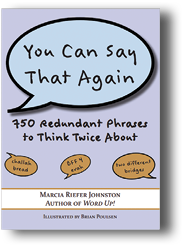 “See inside for details.” One visual-verbal redundancy you will find in You Can Say That Again: 750 Redundant Phrases to Think Twice About. According to Johnston, “Envelopes, in their very envelopeness, say, I envelop something. Guess where you can find it! Hint: It’s not here on the outside” (p. 2). The opening dialog starts the book with its first redundancy where Johnston points solidly to the problems she has found when writing prose. One thought I have is how many of these redundancies occurred from an advertising-style of writing to gain immediate attention. Johnston gives us a few forms of redundancies. Other forms include literal, conceptual, and figurative repetition; colloquial speech; morphology; phonemes in phonology; and rhetoric. I believe that Johnston has a great start with her book.
“See inside for details.” One visual-verbal redundancy you will find in You Can Say That Again: 750 Redundant Phrases to Think Twice About. According to Johnston, “Envelopes, in their very envelopeness, say, I envelop something. Guess where you can find it! Hint: It’s not here on the outside” (p. 2). The opening dialog starts the book with its first redundancy where Johnston points solidly to the problems she has found when writing prose. One thought I have is how many of these redundancies occurred from an advertising-style of writing to gain immediate attention. Johnston gives us a few forms of redundancies. Other forms include literal, conceptual, and figurative repetition; colloquial speech; morphology; phonemes in phonology; and rhetoric. I believe that Johnston has a great start with her book.
The book’s organizational schema is by “alphabetical order within parts-of-speech groupings dotted with blatantly alphabetical thematic or aurally pleasing subgroupings” and interestingly illustrated by Brian Poulsen to match 17 of Johnston’s key redundant phrases (p. 5). The parts-of-speech groupings include adjective phrases (“bald-headed,” “whole entire”); noun phrases (“armed gunman”, “free gift”, “pair of twins”); verb phrases (“breathe in and out”, “Enter, Superman, to the rescue.”); and adverb phrases, odds, and ends (“copyright © 2015”, “equal halves.” Johnston’s sources are recent blog articles from the Grammar Girl and Daily Writing Tips to Bryan Garner’s Garner’s Modern American Usage.
You Can Say That Again is a simple, yet short, inexpensive book that gives you time to reflect on any writing mistakes you are making or have made. This book is a great desk reference resource worth keeping to make sure your writing doesn’t add to the redundant phrase count. And, if you find other redundant phrases, I’m sure that Johnston will gladly add them to her ever-growing list.
Jackie Damrau
Jackie Damrau has more than 20 years of technical communication experience. She is a Fellow and member of the STC North Texas Lone Star chapter and the Instructional Design & Learning SIG. She serves as the book review editor for Technical Communication.
Blogging for Writers: How Authors & Writers Build Successful Blogs
Robin Houghton. 2014. Cincinnati, OH: Writer’s Digest Books. [ISBN 978-1-59963-896-6. 176 pages, including index. US$19.99 (softcover).]
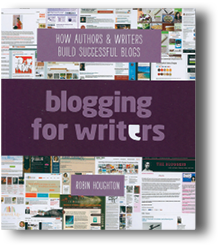 What thoughts does the word “blog” invoke within you? Pleasant reading experience, opportunity for creative writing before an audience, marketing strategy, keeping in touch with followers or customers, one more social media to maintain.
What thoughts does the word “blog” invoke within you? Pleasant reading experience, opportunity for creative writing before an audience, marketing strategy, keeping in touch with followers or customers, one more social media to maintain.
Houghton considers all these responses, and more, in Blogging for Writers: How Authors & Writers Build Successful Blogs. So feel free to jump into the book anywhere you want to learn more.
If you haven’t already done so, Chapters 1 through 3 provide help to think through a blogging persona; understand blog basics, such as pages versus posts; and perform step-by-step procedures to set up a blog using WordPress or Blogger hosting services. Blogs featured in the book are to inspire. Smiling writers, each with a list of credentials, tell of their blog successes. You will be motivated to have a blog up and running in no time.
The next eight chapters contain the information a majority of writers hope to find when opening the book. Suggestions and guidelines for best use of blog features to help capture your desired audience and inspire reader loyalty. At the very least, your blog will look as professional as the writer it represents.
Having recently self-published a book, my agenda while reading Blogging for Writers was to learn how to advertise and sell copies. I already had created two blogs with supportive content, one for the published book and another for the upcoming one. Unfortunately, my choice of WordPress.com would not let me collect email lists—of utmost importance for writers to contact customers about future releases. It was least expensive to create a third blog on WordPress.org to serve as my writer Web site and link to the others. I should have read the first chapters of Houghton’s book a year or more ago!
Next, I made a ”shopping” list: plug-ins such as About page (Chapter 3); customized theme and menus (Chapter 4); featured images and video (Chapter 5); promoting the blog (Chapter 6); adding social media links to avoid posts in multiple locations (Chapter 7); selling from the blog (Chapter 9); and collecting statistics (Chapter 10). More smiling writers promised me I could do all this. Fortunately, the instructions were clear and easy to follow.
What seemed to get lost is the fact that a blogger must be a social creature. Most of the writers I know are introverts, like myself. We can write instructions fifteen steps long, but be social? Chapters 6 and 7 (“How to Get Noticed” and “Let’s Get Social”) give ways to grow a blog community. However, no chapter in Blogging for Writers persuaded me to reply to spam comments or follow other blogs simply because their writers have a large audience.
My blog is seldom visited, though now looks professional. And my business cards boast a QR code (not discussed in the book) that launches the blog from a cell phone. But the fact remains—Content is King (Chapter 5).
Donna Ford
Donna Ford has been an STC member, joining in 1990 and serving on her local chapter’s board for many years. She has been a technical writer since 1987 in the hardware, software, and government healthcare industries. Donna holds a certificate in Information Design from Bentley College.
Intertwingled: Information Changes Everything
Peter Morville. 2014. Ann Arbor, MI: Semantic Studios. [ISBN: 978-0-692-22558-5. 188 pages, including index. $22.50 (softcover).]
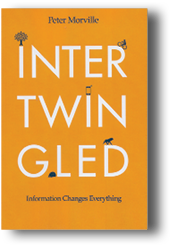 Once in a while, in the midst of all our work reading and creating “how-to” information, we should stop and read a book that makes us think. Intertwingled: Information Changes Everything is such a book.
Once in a while, in the midst of all our work reading and creating “how-to” information, we should stop and read a book that makes us think. Intertwingled: Information Changes Everything is such a book.
The book takes its title from a 1974 work by Ted Nelson in which he commented that “everything is deeply intertwingled”—connected in myriad, intricate ways. Peter Morville’s new book shows us and exhorts us to think about how “it’s vital to see our organizations as ecosystems” and how “all ecosystems are linked” (p. 3).
Morville, one of the information architecture founders and a noted consultant, is really a Renaissance man. Here he draws on many fields and examples from preparing for a solo backpacking trip to Buddhism to basketball coaches, as well as Web sites and other artifacts that resonate with technical communicators.
Intertwingled is full of insights like these:
“Information systems aren’t just code. They are also about content and culture. We must select our frame of reference very carefully, because the solution is shaped by how we define the problem” (p. 26).
“Clients often don’t know what’s wrong. Instead of solving the symptom, I dig for a diagnosis. Design is an intervention” (p. 27).
The book’s tone is conversational. When Morville uses “we,” he is talking most directly to his information architecture colleagues. However, what he says is really for all of us. Not only are technical communicators also often information architects, Intertwingled is about information, content, organization, and life.
Morville’s book is also a treatise on thinking outside the box. As an information architect, he has often had to make clients see new ways of organizing their content. If you’ve ever been in a similar situation trying to help clients or colleagues change, you will find much to like in Intertwingled. As he says, the information age is “a time when learning how to learn (and unlearn) is central to success” (p. 6) and “we must have the courage to dwell in discomfort. Time spent wisely at the start of a project or journey may return dividends for years” (p. 46).
But Intertwingled is not only a meditation. Along the way, Morville gives useful practical advice on organizing information, such as this: “Since every classification is flawed, we should usually use more than one….we are getting better at providing multiple maps and paths, and it’s helping our users enormously” (p. 59).
Intertwingled is a great read and an important contribution, not only to information architecture, but to technical communication. Reward yourself. Get the book.
Janice (Ginny) Redish
Janice (Ginny) Redish is president of Redish & Associates in Bethesda, Maryland, USA. Ginny’s “how-to” book, Letting Go of the Words – Writing Web Content that Works, (Morgan Kaufmann / Elsevier, 2nd edition, 2012) will help you and your colleagues communicate successfully through your Web sites and social media. Ginny is an STC Fellow and a former member of the STC Board of Directors.
Type. A Visual History of Typefaces & Graphic Styles
Cees W. de Jong, Alston W. Purvis, and Jan Tholenaar, eds. 2013. Cologne, Germany: Taschen. [ISBN 978-3-8365-4480-1. 2 vols., 720 pages, including index. US$59.99 (softcover).]
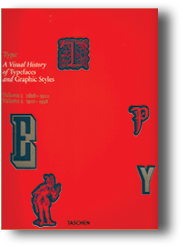 Type: A Visual History of Typefaces & Graphic Styles is a two-volume set presenting a selection of type specimens from the collection of Jan Tholenaar, a Dutch collector who focused on letterpress specimens produced primarily between 1830 and 1930, although this set provides examples from as early as 1628 and as late as 1938. Originally published in a hardcover edition in 2009 and reissued in 2013, this set is best thought of as a personally curated catalog of selections from Tholenaar’s collection rather than a “visual history” as the title suggests. There are some large chronological gaps (for example, the period of 1629 to 1741 is not represented), a heavy weighting of 19th century specimens, and an emphasis on display faces and ornaments.
Type: A Visual History of Typefaces & Graphic Styles is a two-volume set presenting a selection of type specimens from the collection of Jan Tholenaar, a Dutch collector who focused on letterpress specimens produced primarily between 1830 and 1930, although this set provides examples from as early as 1628 and as late as 1938. Originally published in a hardcover edition in 2009 and reissued in 2013, this set is best thought of as a personally curated catalog of selections from Tholenaar’s collection rather than a “visual history” as the title suggests. There are some large chronological gaps (for example, the period of 1629 to 1741 is not represented), a heavy weighting of 19th century specimens, and an emphasis on display faces and ornaments.
The bulk of the set is comprised of type specimen images presented in chronological order printed on high quality paper. Volume 1 covers the years, 1628–1900, while Volume 2 features the years, 1901–1938. Owners of the set gain free access to high-resolution JPEG files of the featured images.
As is typical of Taschen-published volumes, the text is presented in multiple languages (English, German, and French). Essays include an introduction by Cees W. de Jong (designer and publisher based in the Netherlands), an explanation of the collection by Tholenaar, and an essay by Alston W. Purvis (professor at Boston University) titled “Type Foundries: The Golden Age.” Purvis’ entry is by far the most coherent and useful of the essays; the others are poorly written and read as a set of unconnected paragraphs haphazardly strung together. Even the image captions would have benefited from thoughtful editing. For an 1878 specimen, the caption simply reads, “These samples show unprecedented possibilities. Letterpress technology now knows no bounds.” (Vol. 1, p. 176).
If the reader is in need of general “inspiration” for font selection, of historical examples to use in the classroom or visually interesting volumes to adorn his coffee table, then this set might be useful. Otherwise, the typical technical communicator will find little value in Type: A Visual History of Typefaces & Graphic Styles.
Lee Andrew Hilyer
Lee Andrew Hilyer is the head of Information & Access Services at the University of Houston Libraries. He received his M.Ed. in instructional technology from the University of Houston and is the author of Presentations for Librarians: A Complete Guide to Creating Effective, Learner-Centered Presentations (Chandos, 2008).
Theories of the Information Society
Frank Webster. 2014. 4th ed. New York, NY: Routledge. [ISBN 978-0-415-71879-0. 404 pages, including index. US$55.95 (softcover).]
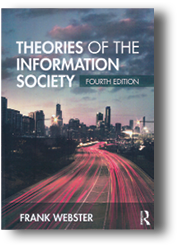 Webster’s Theories of the Information Society is a sociological study of the society, variously named, but essentially a society involving information. This scholarly book, now in its fourth edition, will have limited appeal for technical communicators; it is best suited for a graduate course focusing on information’s role in society.
Webster’s Theories of the Information Society is a sociological study of the society, variously named, but essentially a society involving information. This scholarly book, now in its fourth edition, will have limited appeal for technical communicators; it is best suited for a graduate course focusing on information’s role in society.
The book’s structure falls into three sections: An overview of the field (Chapters 1–3); addressing specific theories and theorists (Chapters 4–12); and Webster’s own views on why Information Society as a label is flawed and ultimately misleading (Chapter 13).The theorists he addresses include Daniel Bell; Manual Castells; Herbert Schiller; Jürgen Habermas; Frederick von Hayek; and Anthony Giddens.
Webster’s argument is that there is not enough evidence to label the current age as the Information Society as the various theorists want to do; therefore, each of the theories are inadequate when naming the current age. One interesting point he makes is that, while the theorists and groups he discusses focus on information and information products, one theorist suggests that the better view is obtained when you examine the sources and controllers of that information rather than the information itself.
While several chapters focus on a single theorist, others discuss several theorists—no principle scholar is identified with the topic. These chapters address a broader range of theories; for example, Chapter 5 discusses capitalism and Chapter 7 mobilities (such as Apple products). The various theorists address directly or indirectly how information influences and shapes society. Another issue is whether the political entities should be involved in information; for example, surveillance.
For Webster, the key is his skepticism about information becoming “the major distinguishing feature of our times” (p. 24). The problem is that the theorists label society the information society based on the quantity of information available when compared with past years.
The focus of the book’s title is society and information, so, we have a society, but what kind of society is it? Webster does not challenge information society, but rather challenges the basis for the term. To help his readers understand his approach, Webster claims to be an advocate for capitalistic democracy, and that is the lens through which he views the theories. He seems to lean toward “theoretical knowledge” that involved capitalism as the basis for the designation. By theoretical knowledge, he refers to the theories behind information products. He concludes that “we may best appreciate information trends by situating them within the context of capitalist development” (p. 347).
Be aware, though, that Theories of the Information Society is not easily read because it is meant to be a textbook used in advanced sociology classes. Also, the critiques require at least some familiarity with the theorists’ views. Yet, for those who spend the time, the wealth of material can help them understand how information is shaping, in his view, capitalistic democracy. Fortunately, his style is easily accessible and the myriad references do not get in the way.
Tom Warren
Tom Warren is an STC Fellow, Jay R. Gould Award for Excellence recipient, and professor emeritus of English (technical writing) at Oklahoma State University, where he established the BA, MA, and PhD technical writing programs. Past president of INTECOM, he serves as guest professor at the University of Paderborn, Germany.
Global Content Strategy: A Primer
Val Swisher. 2014. Laguna Hills, CA: XML Press. [ISBN 978-1-937434-40-3. 86 pages, including index. US$19.95 (softcover).]
 Global Content Strategy: A Primer is an excellent book for someone new to the global content strategy field. Swisher defines global content strategy, gives you tips on finding your content, and shares brief insights into how certain word phrases or gestures can get you in trouble when translating content. She then briefly talks about transcreation and the Translation Memory dance, and concludes by discussing the global content strategy revolution.
Global Content Strategy: A Primer is an excellent book for someone new to the global content strategy field. Swisher defines global content strategy, gives you tips on finding your content, and shares brief insights into how certain word phrases or gestures can get you in trouble when translating content. She then briefly talks about transcreation and the Translation Memory dance, and concludes by discussing the global content strategy revolution.
A global content strategy plan manages content “intended for people whose main language is something other than the source language” (p. 2). A global content strategy involves knowing where you are and where you want to be, doing a gap analysis, and moving toward a global content strategy solution. When developing your global content strategy, you should “cover global considerations implicitly,” which is why “we need books like this to show how it’s done” (pp. 5-6).
Finding your content helps minimize your translation costs. Knowing where your content is “created, stored, used, reused, and consumed” (p. 7) helps during the content audit. Swisher recommends using a content matrix that details where the content is, if it is localized, translated, or transcreated; number of languages; if translation memory is being; the translation vendors being used for each content source; and the translation reviewers both domestic and global.
Content translation can pose problems when you use the wrong words, pictures, symbols, icons, maps, flags, or gestures. Always make sure that these items are culturally appropriate for the audience. Analyze your images for universality and appropriateness before putting them in your documents to make sure you don’t offend your readers.
Transcreation creates content—words and images—for every culture using that country’s vernacular. With transcreation, you may need to change the message or expression of sentiment to be culturally appropriate and understood. Swisher shows several transcreated Web sites from Coca-Cola with examples of how well they effectively targeted every culture and country, making these sites pleasing to look at, yet maintaining the corporate branding and marketing standards.
Delving further into global content strategy involves considering the translation memory and its effect on your content as well as doing the Translation Memory Exchange (TMX) dance. In that dance, you synchronize all the translation memories that reside individually at each language service provider by requesting each one to export their (really your) translation memory database into a standard file type, known as TMX.
Global Content Strategy is a short, easy read. The largest problems you will find are the size of the graphics and the grammatical mistakes in the book. The graphics are too small for you to focus on the details that Swisher wants you to view. The minor annoyances with the grammatical mistakes do not detract too much, yet in such a small book, I wouldn’t expect them to be there.
Jackie Damrau
Jackie Damrau has more than 20 years of technical communication experience. She is a Fellow and member of the STC North Texas Lone Star chapter and the Instructional Design & Learning SIG. She serves as the Technical Communication book review editor.

